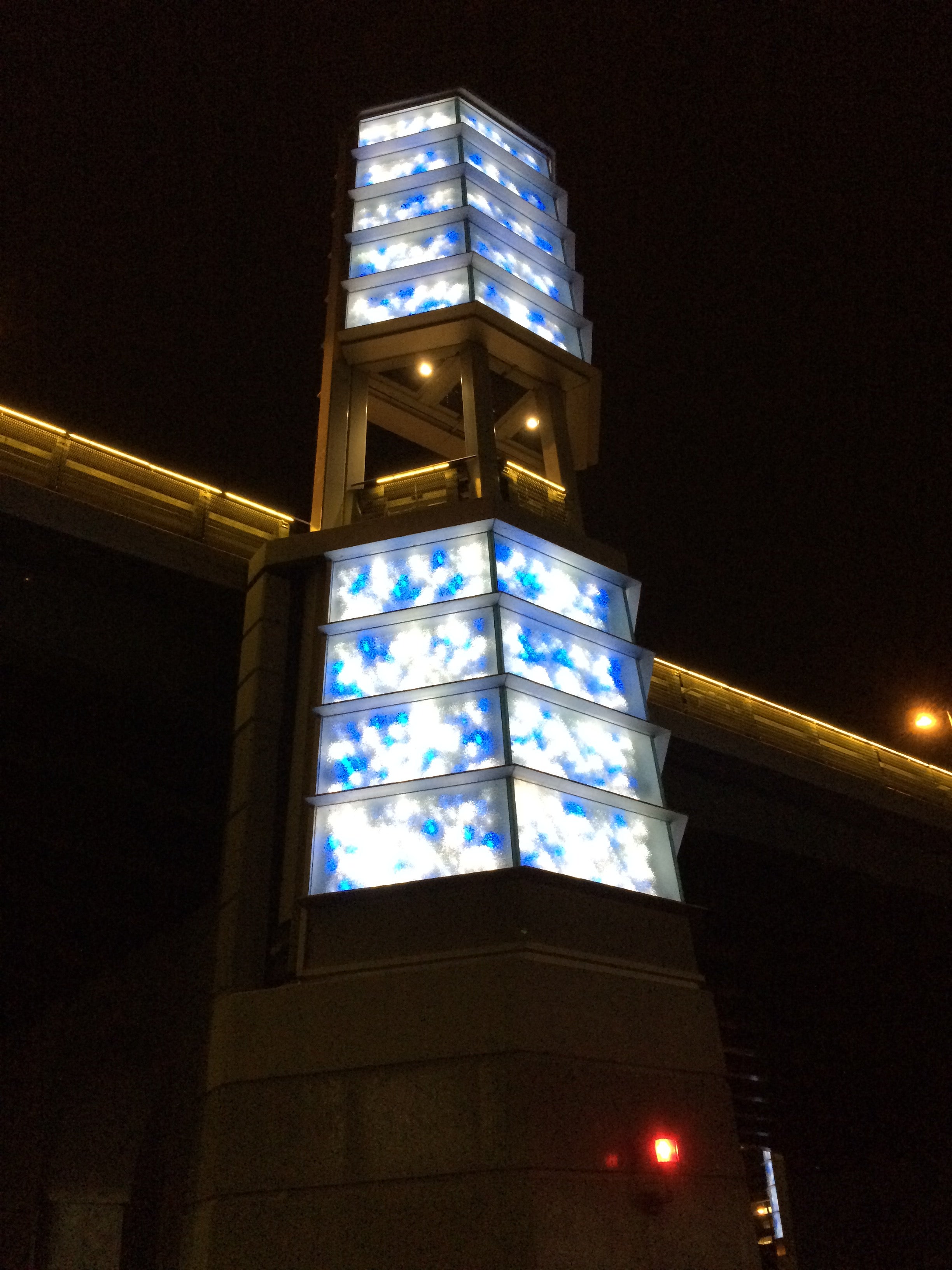DAGspace: The difference between a bridge and television
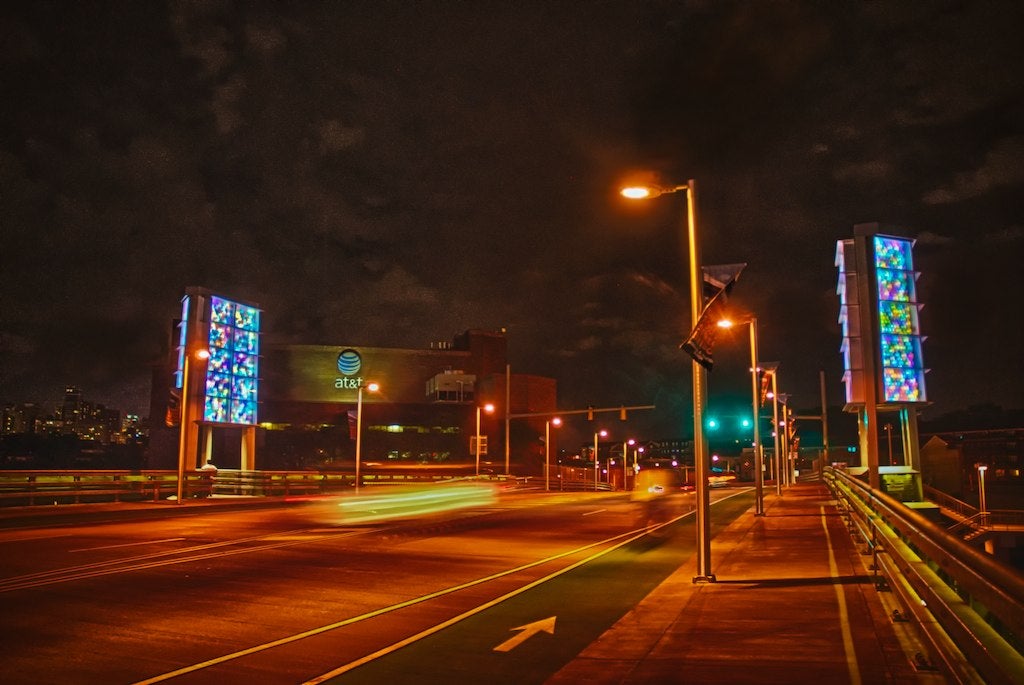

In this month’s DAGspace, architect Timothy Kerner considers the South Street Bridge’s LED lanterns and asks the city to do us one better than the photo-unrealistic dancer sihouettes and Eagles ads.
Kerner is principal of Terra Studio and an adjunct professor of urban design at Temple Univeristy. DAGspace articles express the opinions of their authors and do not necessarily reflect the views of the Design Advocacy Group.
A well-illuminated bridge can be an inspiring nighttime sight, and the nationally recognized Schuylkill River Trail provides some striking examples. The taut, riveted steel beneath JFK Boulevard contrasts with the glowing, classical mass of 30th Street Station. The white and blue reflections in the rippling water beneath the Market Street arches are surprisingly sublime. The massive piers of the Chestnut and Walnut Bridges defiantly impose themselves upon the trail.
We then come to the newest and most peculiar of the Schuylkill bridges. There is something very Philadelphia about the South Street Bridge. After all, it owes its final form to the type of public jostling we do best – with dedicated community activists, talented designers, steadfast city officials and the last minute intervention of a subsequently jailed political kingpin. I would like to love the South Street Bridge, but it requires some effort.
In contrast to the atmospheric illumination of the Market Street Bridge, the structure below South Street is hidden in darkness. Instead of the satisfying masonry masses of the Walnut and Chestnut bridge piers, the South Street supports are clad below the roadway with illuminated panels, which continue, after an odd interruption, up on stilts above the roadway. On the bridge surface, the stripped down details do not offer much to be passionate about, aside from the highly negotiated widths of the bike and pedestrian pathways. All attention focuses on the four jumbo-sized lanterns that perform a nightly pre-programmed light show.
Contrary to the city administration’s early assertions that the lanterns would display gentle patterns of light, all the stops are pulled out on a nightly basis. Falling waves of oranges, blacks and reds are followed by pulsating green ribbons, followed by yellow and blue squiggling worms. I have to admit the whole thing had me baffled for a while. The first imagery that came to mind was a roadway supported by four lava lamps. This made some sense; the color movements often have a murky, viscous look and, as everyone knows, South Street is the best place to purchase lava lamps. But sometimes the bridge does things lava lamps just can’t do, such as bursts of psychedelic patterns or glowing dancers pirouetting across the faceted surfaces.
Then it hit me – kaleidoscopes. The shape of the four prismatic pylons are reminiscent of that optical device’s internal reflective surfaces, and the speed of the color changes could only be accomplished by light and mirrors, not viscous liquids. I once visited what was claimed to be the “world’s largest kaleidoscope” – on a back road in the Catskills. It was built in an old barn silo, or so it appeared, and was appropriately not far from Woodstock. I don’t know if it still exists, but that doesn’t matter, Philadelphia has the only bridge in the world supported by four kaleidoscopes!
Kaleidoscope is an interesting word – a nineteenth century assembly of three Greek terms meaning beauty, form and to look at. When F. Bielefeld, a “well known optician of Philadelphia” invented a new type of kaleidoscope in 1873, the Journal of the Franklin Institute declared, “The inventor has intended the instrument to be of service to designers of patterns for textile fabrics…the facility with which a happy pattern can be modified indefinitely by the adjustable property of this device, will prove of much convenience and advantage; while as a scientific toy, the beauty of its effects…will doubtless render it popular.”
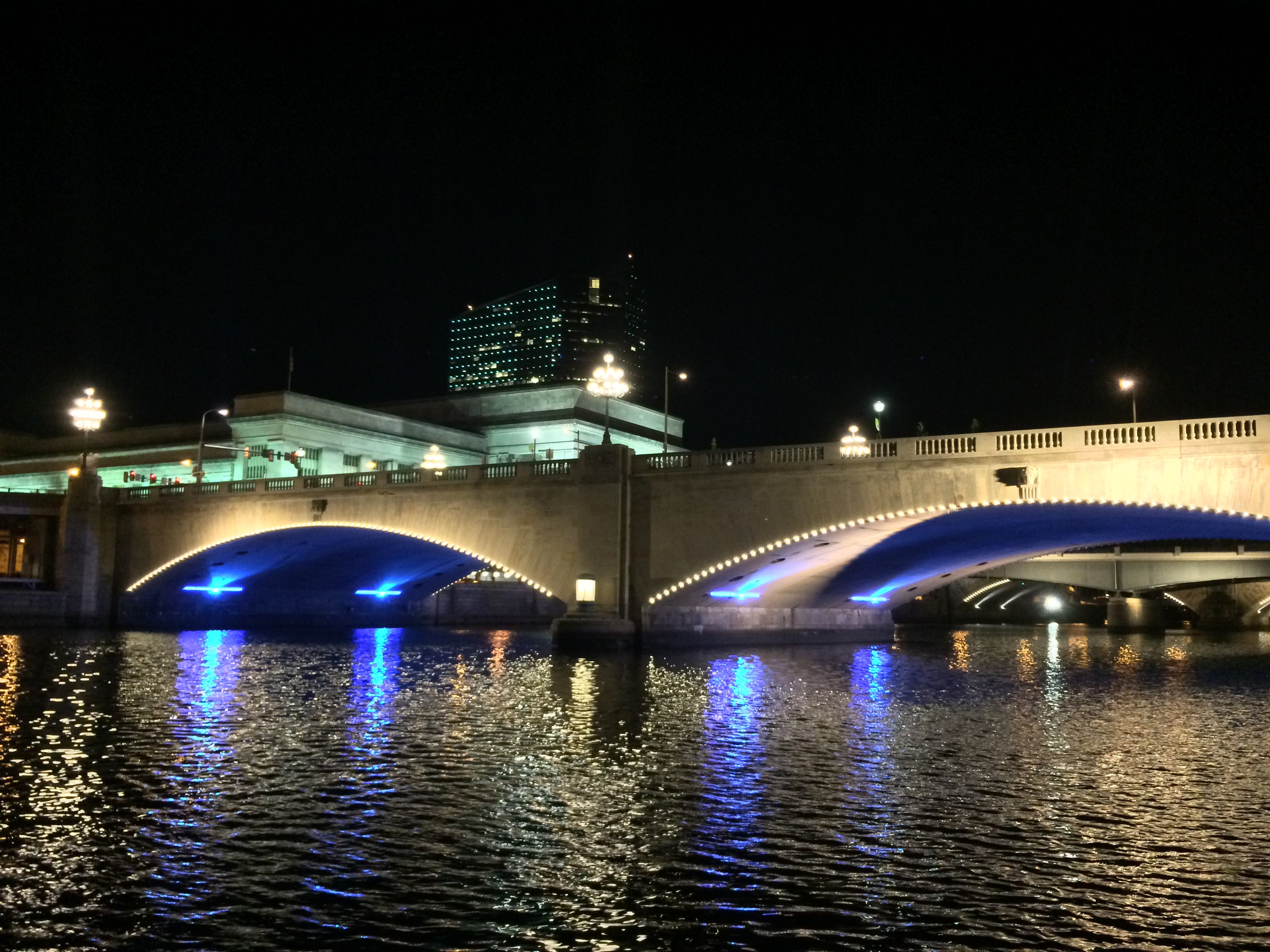
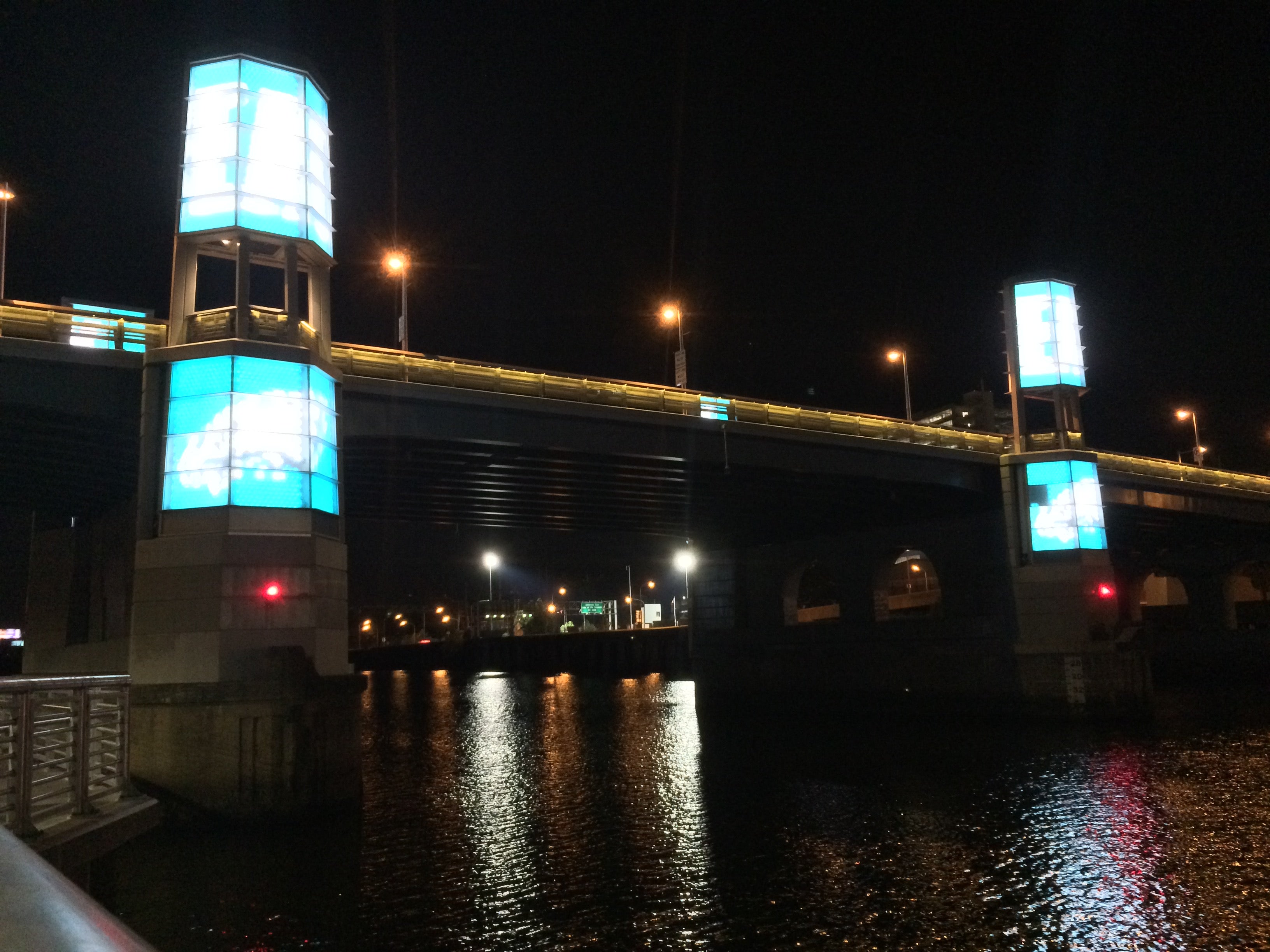

With a new understanding of the essence of the South Street Bridge, I set out on my bike one night with expectations of quadruple kaleidoscope enjoyment. Unfortunately, I was met with a disappointing sight. The psychedelic colors and the range of kaleidoscopic effects were gone. Instead, there were green and white eagle heads and streaming letters declaring “EVERY FALL WE RISE.” Despite the desperate hope implicit in this message, a serious line had been crossed; we had gone too far.
Sure, let’s hang Eagle flags on every light pole in the city and let’s bleed green every Sunday. But certain distinctions need to be made, or we might as well throw in the towel and forget about the urban environment. A bridge is important to the city, both functionally and symbolically. It is a point of crossing, a gateway and a monument laden with meaning about our relationship with the land and water. At best, a bridge can be a stunning landmark with collective significance. When a bridge’s predominant form is turned into a video screen for advertising and promotion, the city has lost something of value.
There are already far too many TV screens in our lives, and they are all filled with streaming words. We have screens in our family rooms, on our desks, on our phones, in our cars, along our roads, in restaurants, even in elevators. The eye doctor tells us we need to look up from our screens every now and then and view the outside world to rest our eyes. That seems like sound advice. When I look outside, I like to see well-designed buildings, vibrant streetscapes, beautiful bridges, trees and water. What I do not want to see out there are more televisions and more advertising.
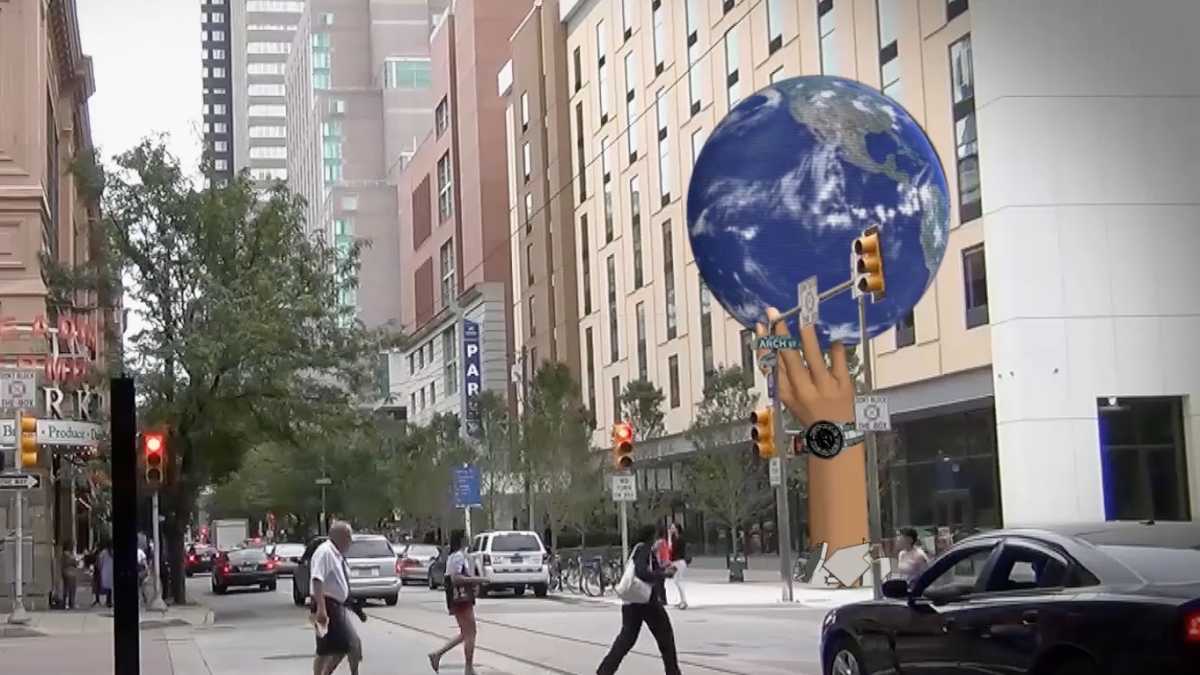
Some may think a huge, outdoor TV is a novel thing. The city is now in the process of proving them wrong. Besides the recent addition of LED advertising panels on top of the historic Lit Brothers building and the designated electronic advertising zone on East Market Street (dubiously promoted as a future mini-Times Square), other “Urban Experiential Displays” will soon be popping up. City Council just approved the imminent installation of a giant hand holding an LED sphere – seeming to burst though the sidewalk across the street from the Reading Terminal Market. Apparently, the way to mitigate the invasion of our public realm with illuminated advertising is to add a dose of cartoonish kitsch.
The prerequisite of advertising is to prioritize message over place. The green and white Eagles display has nothing to do with South Street or the Schuylkill River. And if the bridge advertises the Eagles today, why not advertise CHOP tomorrow, and then Independence Blue Cross? How about Comcast – arguably the most important company in the city? And if we allow the bridge to be defined as a TV bridge, it won’t be long until Coke and Pepsi are clamoring at City Hall’s new gates demanding air time and offering free soda to the public schools. For the sake of the children, we need to draw a firm line and declare it, the Kaleidoscope Bridge.
The South Street Bridge was built with public money and presented to the city as a landmark structure. Here’s a simple rule of thumb: public landmarks (bridges and bells, for example) should not be used for advertising or promotion. To use the bridge this way is a debasement of its civic importance and a degradation of the essence of a kaleidoscope. The City Administration, the Streets Department and anyone else who might have their hands on the bridge lighting controls should treat our public realm with a bit more respect. The South Street Bridge was designed to display dynamic patterns of color and light that aspire towards artistic expression. Philadelphia has the talent to do this in a unique and intriguing way – as long as we keep advertising off our kaleidoscopes.
DAGspace is an opinion column written by members of the Design Advocacy Group (DAG), with the goal of promoting good design by encouraging thoughtful public discussion of design matters. The mission of the Design Advocacy Group is to provide an independent and informed public voice for design quality in the architecture and physical planning of the Philadelphia region.
DAG’s monthly meetings are on the first Thursday of the month at 8am sharp, at the Center for Architecture (1218 Arch Street).
WHYY is your source for fact-based, in-depth journalism and information. As a nonprofit organization, we rely on financial support from readers like you. Please give today.




